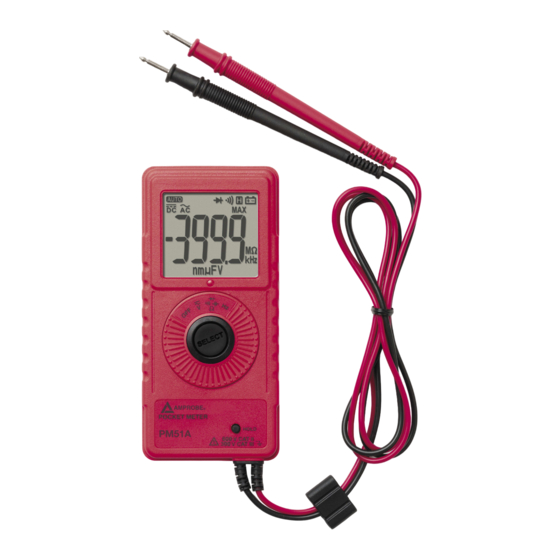
Table of Contents
Advertisement
Quick Links
Advertisement
Table of Contents

Summary of Contents for Amprobe PM51A
- Page 1 PM51A Pocket Multimeter Users Manual...
- Page 2 PM51A LCD display Rotary switch to select functions and to turn the power on or off SELECT-button to select alternate functions. Permanently attached red test lead for positive (+) polarity and black test lead for ground reference (-) HOLD button to freeze the display for later viewing.
-
Page 3: Safety Information
Introduction The PM51A meter is a shirt-pocket size meter only 19 mm (.75 in) wide and weighing less than 85 g (3 oz). With full functionality offering AC and DC voltage to 600 V, resistance to 40 MΩ, capacitance to 300 µF, frequency to 1 MHz, continuity with beeper, and diode test. Fully autoranging, the PM51A offers seven different measurement functions with 27 full ranges of measurement. -
Page 4: Symbols Used In This Manual
Symbols Used in this Manual Battery Refer to the manual Double insulated Dangerous Voltage Direct Current Earth Ground Alternating Current Audible tone > Underwriter Laboratories, Inc. Complies with EU directives Making Measurements All measurements described in this manual use the red test lead for positive (+) polarity and the black test lead for ground reference (-) unless otherwise specified. -
Page 5: Dc And V Ac Functions
V dc and V ac Functions Rotate the rotary selector to the V position. V dc is the default function. The dc annunciator F appears on the display. Press the SELECT button momentarily to select V ac. The ac annunciator B appears on the display. -
Page 6: Maintenance
Frequency Function Turn the rotary switch to the Hz position to select the frequency function. This function is set only at the highest input sensitivity mainly for measuring small electronic signals below 20 V ac rms. 1. Connect the test probes to the signal source. 2. -
Page 7: Battery Replacement
Battery Replacement If the meter starts up with persistent resetting display or with low battery icon N turns on, replace the battery. The meter uses one 3 V coin battery, IEC-CR2032. To replace the battery 1. Turn off the meter and disconnect the test leads from live circuits. 2. - Page 8 Display and Update Rate: 3-3/4 digits 4000 counts; Updates 3 per second nominal Operating Temperature: 0 °C - 40 °C Relative Humidity: Maximum 80% R.H. up to 31 °C, decreasing linearly to 50% R.H. at 40 °C Altitude: Operating below 2000 m Storage Temperature: -20 °C ~ 60 °C, <...
-
Page 9: Electrical Specifications
Special Features Data Hold, and 30ms MAX Hold Agency Approvals P > Safety: Meets IEC61010-1, UL61010B-1, CAN/CSA-C22.2 No. 1010.1-92, CAT II 600 V and CAT III 300 V, Pollution Degree 2, Class 2 E.M.C. Meets EN61326 (1997, 1998/A1), EN61000- 4-2 (1995), and EN61000-4-3 (1996). This product complies with requirements of the following European Community Directives: 89/ 336/ EEC (Electromagnetic Compatibility) and 73/ 23/ EEC (Low Voltage) as amended by 93/ 68/ EEC (CE Marking). - Page 10 AC Voltage Range Accuracy 50 Hz – 60 Hz ±(2.0%+5 dgt) 4.000 V, 40.00 V, 400.0 V 60 Hz – 500 Hz ±(3.0%+5 dgt) 4.000 V, 40.00 V, 400.0 V 50 Hz – 500 Hz ±(3.5%+5 dgt) 600 V Input Impedance: 10 MΩ, 30 pF nominal CMRR: >...
- Page 11 Ohms Range Accuracy 400.0 Ω ±(1.5%+6 dgt) ±(1.0%+4 dgt) 4.000 KΩ, 40.00 KΩ, 400.0 KΩ ±(1.5%+4 dgt) 4.000 MΩ ±(2.5%+4 dgt) 40.00 MΩ Open Circuit Voltage: 0.4 V dc typical Frequency Range Accuracy ±(0.5%+4 dgt) 400 Hz, 4 kHz, 40 kHz, 400 kHz, and 1 MHz Specified at Input Voltage <...










